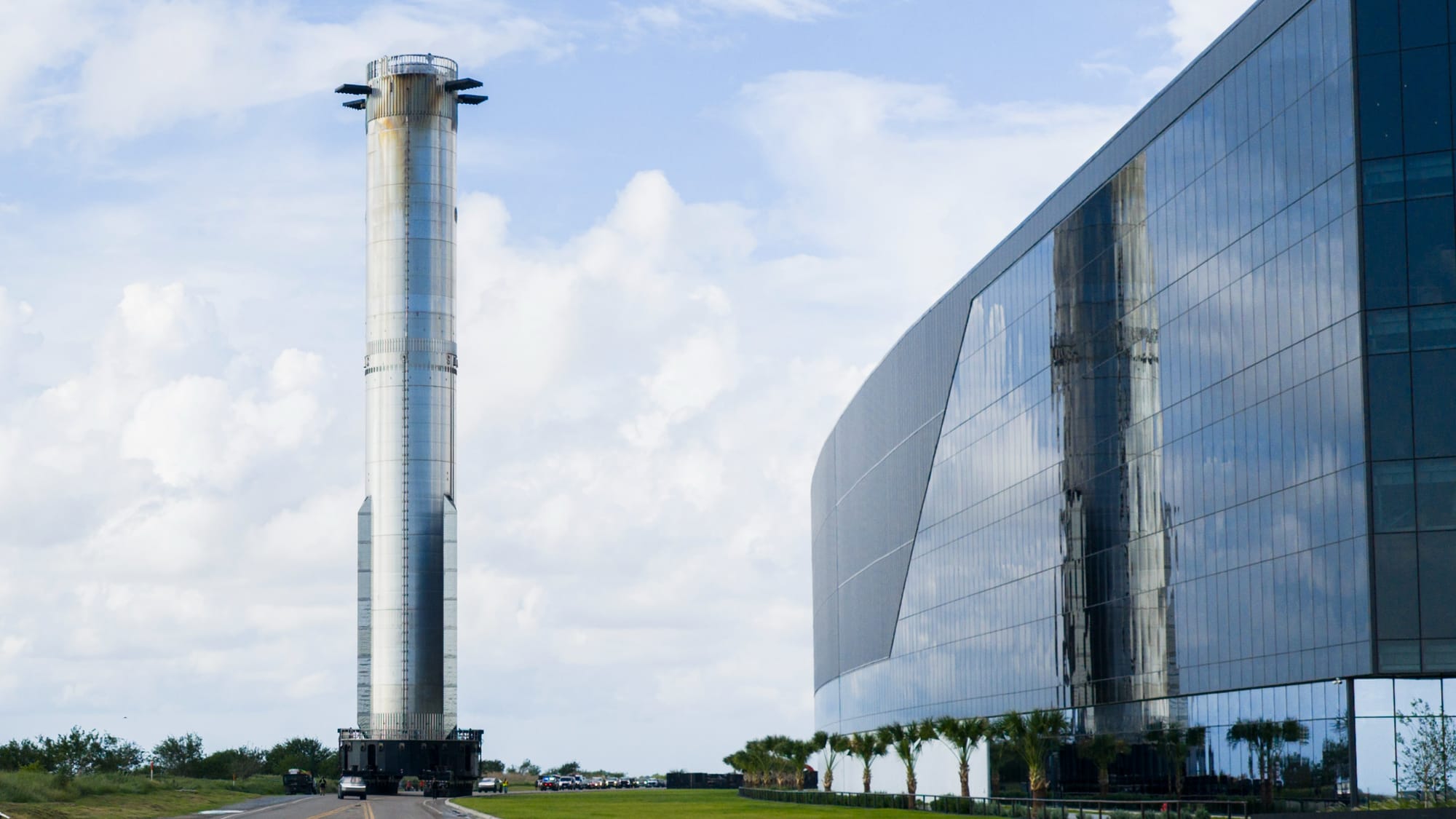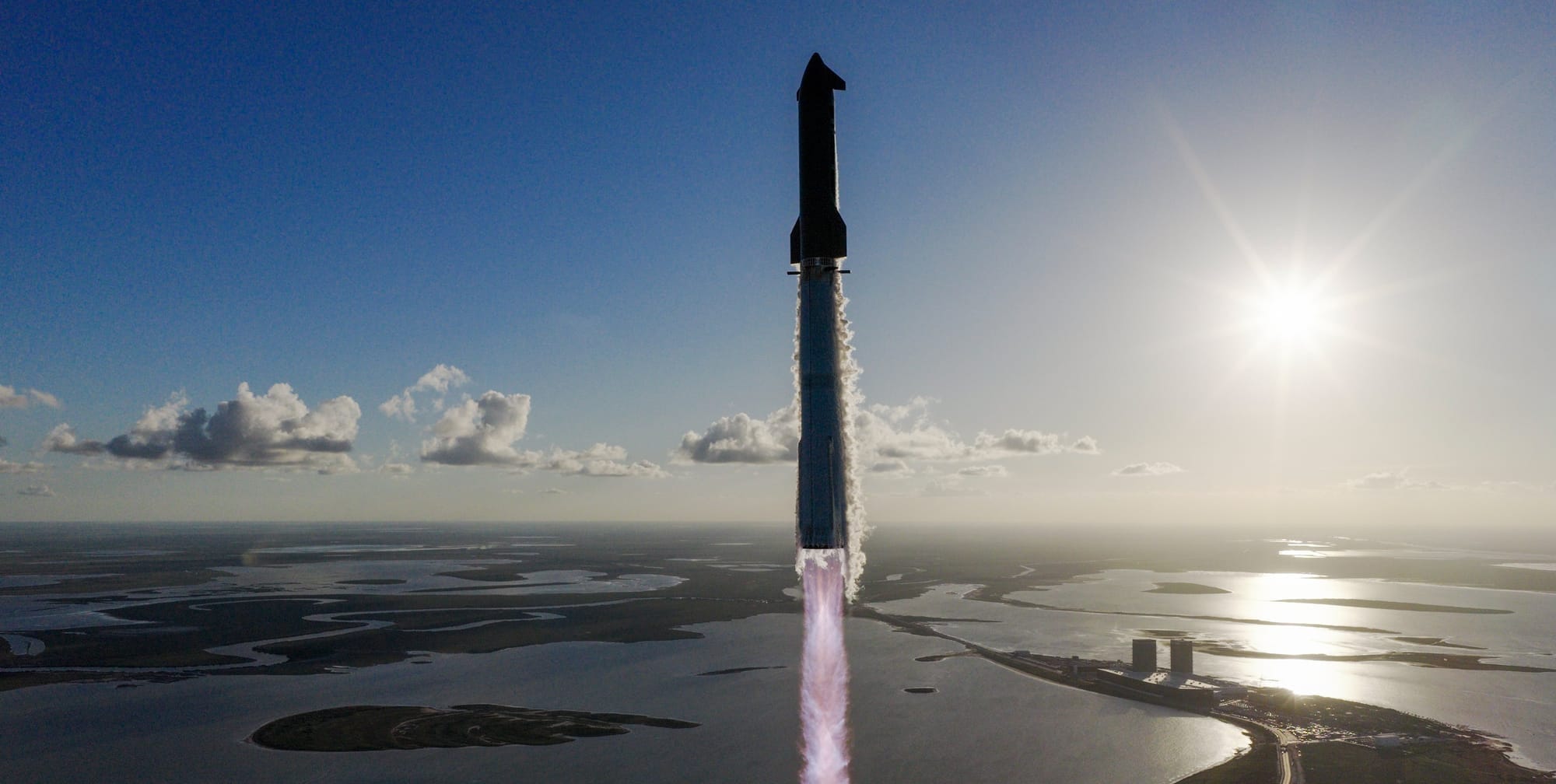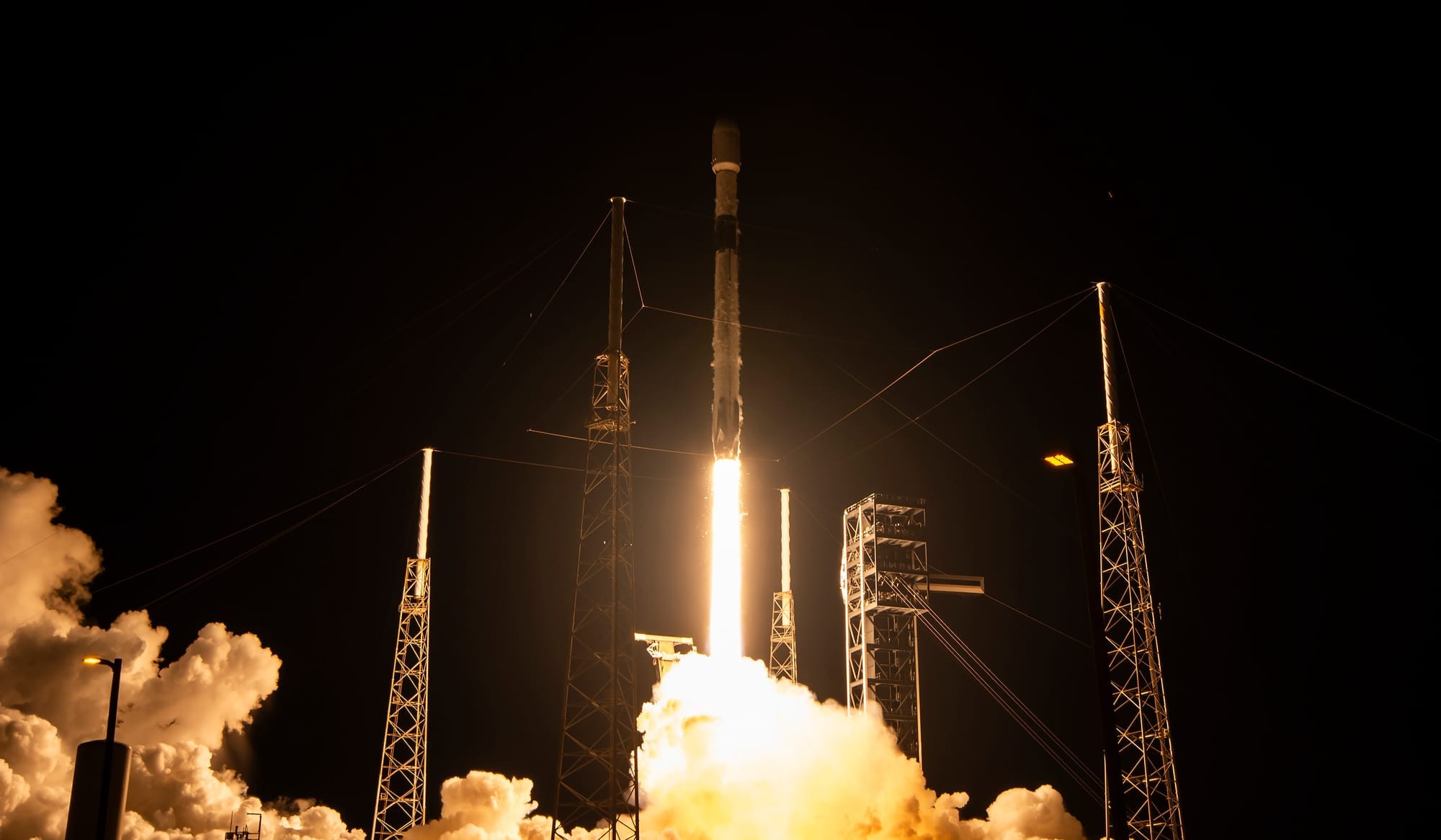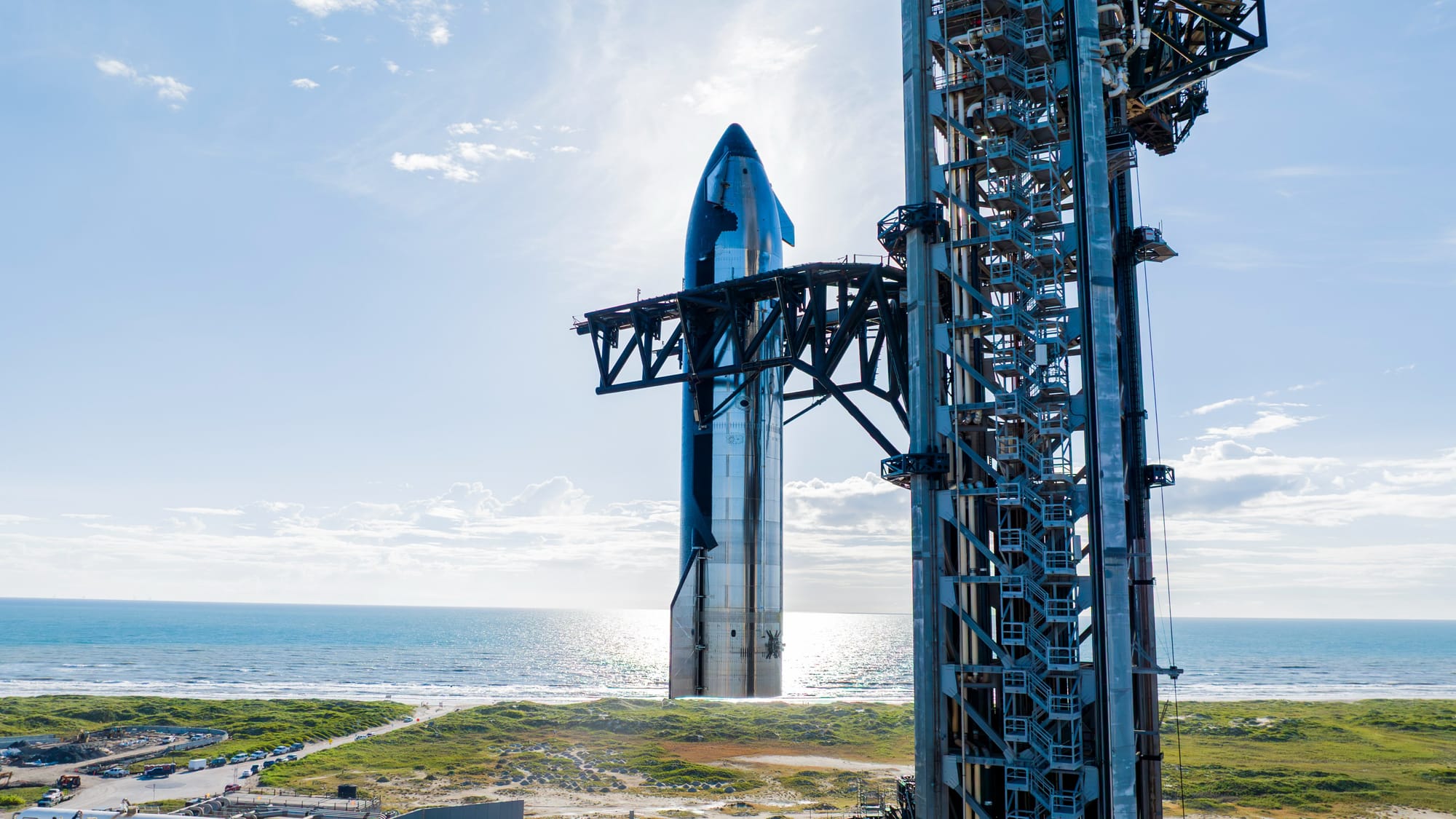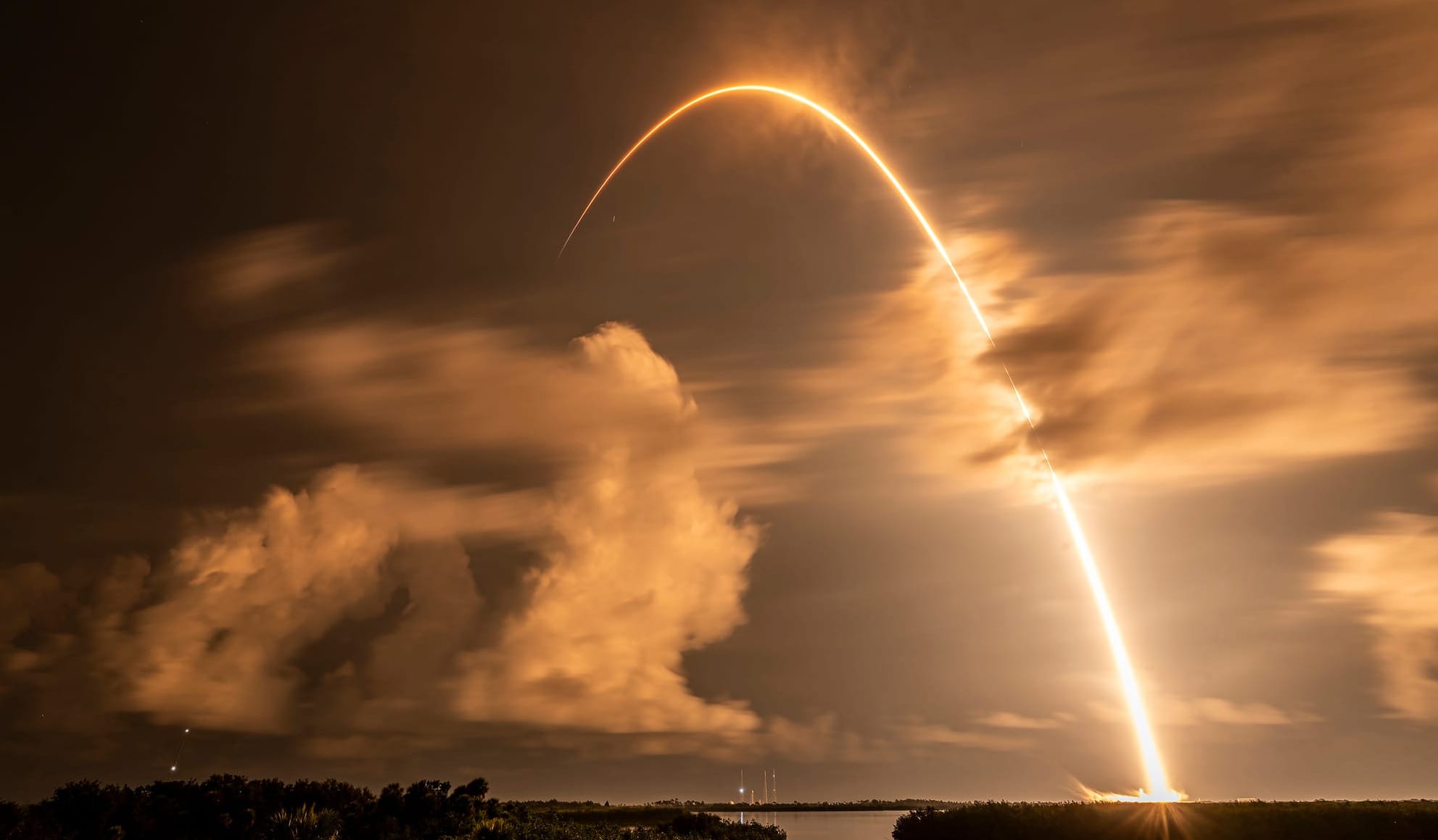Table of Contents
Starship-Super Heavy performed the vehicle's second and final successful 'Block 2' flight ahead of a critical design change.
Two weeks ago, SpaceX announced that Ship 38, for its first flight and the final launch of a 'Block 2' Starship, and Super Heavy Booster 15, flying for the second time, were set to perform Starship-Super Heavy's eleventh flight test and the final flight from Pad 1 in its current design. Details shared before the test flight said that Ship 38 would release eight dummy Starlink satellites and perform an in-space demonstration burn, before splashdown in the Indian Ocean, with Booster 15 demonstrating a new landing burn above the Gulf of Mexico.
With Pad 1's deluge system activated, thirty-three Raptor engines ignited under Booster 15 to carry it and Ship 38 skyward. No engines went out on ascent this flight.
Liftoff of Starship! pic.twitter.com/sbfmGAEPa6
— SpaceX (@SpaceX) October 13, 2025
Starship-Super Heavy lifting off for the eleventh time to perform the vehicles latest flight test, via SpaceX on Twitter.
After a nominal ascent, Booster 15 shut down all but three of its engines while angling into a staging position. A few moments later, Ship 38 ignited its three sea-level and three vacuum-optimized Raptor engines to separate and continue up toward space.
Starship’s Raptor engines ignite during hot-staging separation. Super Heavy is boosting back towards its splashdown site and preparing for its landing burn experiment pic.twitter.com/oCy90IFitO
— SpaceX (@SpaceX) October 13, 2025
Ship 38 staging from Booster 15 during ascent through the atmosphere, via SpaceX on Twitter.
Following vehicle separation, the booster began to mostly head back toward the launch site, with all but one of the thirteen engines relighting. Despite that the booster performed its unpowered descent toward the Gulf as planned, it then ignited thirteen engines, dropping to five, then three for a hard splashdown.
Super Heavy has splashed down in the Gulf of America, gathering data for the next generation booster pic.twitter.com/o72ciKBZYm
— SpaceX (@SpaceX) October 13, 2025
Super Heavy Booster 15 splashing down in the Gulf of Mexico, via SpaceX on Twitter.
Meanwhile, Ship 38 was heading toward space for its suborbital trajectory. That was achieved when three vacuum-optimized engines shut down, followed by the three sea-level Raptors for Starship 'Block 2's second and final successful ascent.
Starship’s ascent burn is complete and is now coasting through space pic.twitter.com/UrNg19ElX5
— SpaceX (@SpaceX) October 13, 2025
Ship 38 shutting down its six Raptor engines to complete ascent, via SpaceX on Twitter.
After the ascent, Ship 38 began performing its in-space demonstration. The first of which was the deployment of eight dummy Starlink satellites through a small door on the vehicle.
Starship has successfully deployed our @Starlink simulators pic.twitter.com/muNMalZkbT
— SpaceX (@SpaceX) October 13, 2025
Ship 38 realising dummy Starlink satellites out into space, via SpaceX on Twitter.
Once the dummy satellites were released, a single sea-level Raptor relit to demonstrate an in-space burn.
Starship has successfully ignited one of its Raptor engines while in space pic.twitter.com/1OCFl5icUe
— SpaceX (@SpaceX) October 14, 2025
A single Raptor sea-level engine performing an in-space demonstration burn, via SpaceX on Twitter.
With the demonstrations completed, Ship 38 powered towards its descent, entering through the heat of atmospheric reentry.
Live views brought to you by @Starlink pic.twitter.com/6uFFPLEaQr
— SpaceX (@SpaceX) October 14, 2025
Ship 38 during atmospheric reentry toward the end of its suborbital trajectory, via SpaceX on Twitter.
During the descent, Ship 38 performed the first controlled banking following atmospheric reentry. That guided the vehicle toward a selected spot in the Indian Ocean.
Starship is executing a banking maneuver that mimics the final approach it would take while returning to Starbase for a catch on a future mission pic.twitter.com/t4Al1xg7Xe
— SpaceX (@SpaceX) October 14, 2025
Ship 38 banking to steer its descent through the atmosphere, via SpaceX on Twitter.
Following the second and final toasty reentry of Starship 'Block 2', Ship 38 transitioned into its 'bellyflop' position to slow the vehicle for the final few kilometers of flight. With seconds left in descent, three sea-level Raptors reignited for the 'flip-and-burn', bringing the vehicle to a soft splashdown. Seconds later, the vehicle fell sideways and exploded, sending its nose flying.
Splashdown confirmed! Congratulations to the entire SpaceX team on an exciting eleventh flight test of Starship! pic.twitter.com/llcIvNZFfg
— SpaceX (@SpaceX) October 14, 2025
Ship 38 performing its splashdown in the Indian Ocean, via SpaceX on Twitter.
What's next for Starship?
With Starship-Super Heavy having conducted its final 'Block 2' test flight, all development efforts for the launch vehicle are being shifted toward 'Block 3', with its taller Ships, Boosters, alongside production Raptor 3 engines, and a brand new launch pad. It remains to be seen if a 'Block 3' Starship will have any changes to the flight plan. Test flight thirteen of the Starship program could be the earliest an orbital flight could occur, likely sometime in 2026.
This year was previously planned to be a key year for the Starship program, as a Ship-to-Ship propellant transfer was expected by NASA, now moved many months into 2026 as this year saw three failures before success. Propellant transfer between two vehicles is critical for getting the Starship lunar lander out to the Moon, and returning American astronauts to the surface through the Artemis program.
What is Starship-Super Heavy?
Starship-Super Heavy is SpaceX's in-development fully reusable super heavy-lift launch vehicle and the largest rocket currently flying. SpaceX is currently aiming to have the launch vehicle deliver one-hundred and fifty tons to low Earth orbit while reused or two-hundred and fifty tons when expended, although there are rumors from SpaceX of an expendable payload capacity of three-hundred tons.
On the launch pad, Starship-Super Heavy is one-hundred and twenty-four meters tall and weighs 5,000,000 kilograms fully fuelled. The diameter of both vehicles is nine meters, excluding aerodynamic control surfaces.

What is Starship?
Starship is the second-stage of the Starship-Super Heavy launch vehicle and is planned to be capable of multiple missions into orbit, after a short refurbishment. The vehicle is fifty meters tall and nine meters in diameter, excluding its four aerodynamic control surfaces. Fully fuelled with liquid methane and liquid oyxgen Starship is believed to weigh 1,300,000 kilograms with an approximate weight of 100,000 kilograms unfuelled.
The Starship second-stage is powered by three sea-level Raptor engines along with three vacuum-optimized Raptor engines. These sea-level engines are believed to generate 230 tons of thrust each with the vacuum-optimized engines generating 258 tons of thrust each for a total combined 1,500 tons of thrust for Starship. The vacuum-optimized Raptors are unable to gimbal requiring the sea-level Raptors for control of the second-stage on ascent and landing.
In order to survive re-entry for reuse, Starship has several thousand thermal protection tiles on one side of the vehicle and on all four of its aerodynamic control surfaces. The four control surfaces help guide the vehicle during re-entry and prior to landing inside the atmosphere at a pre-determined location. Starship also has a series of small thrusters to control the vehicle in space before re-entry.
SpaceX is believed to be working on a few variants of Starship for use as a Moon lander, propellant tanker, space station, Mars lander, and as a crewed spacecraft.
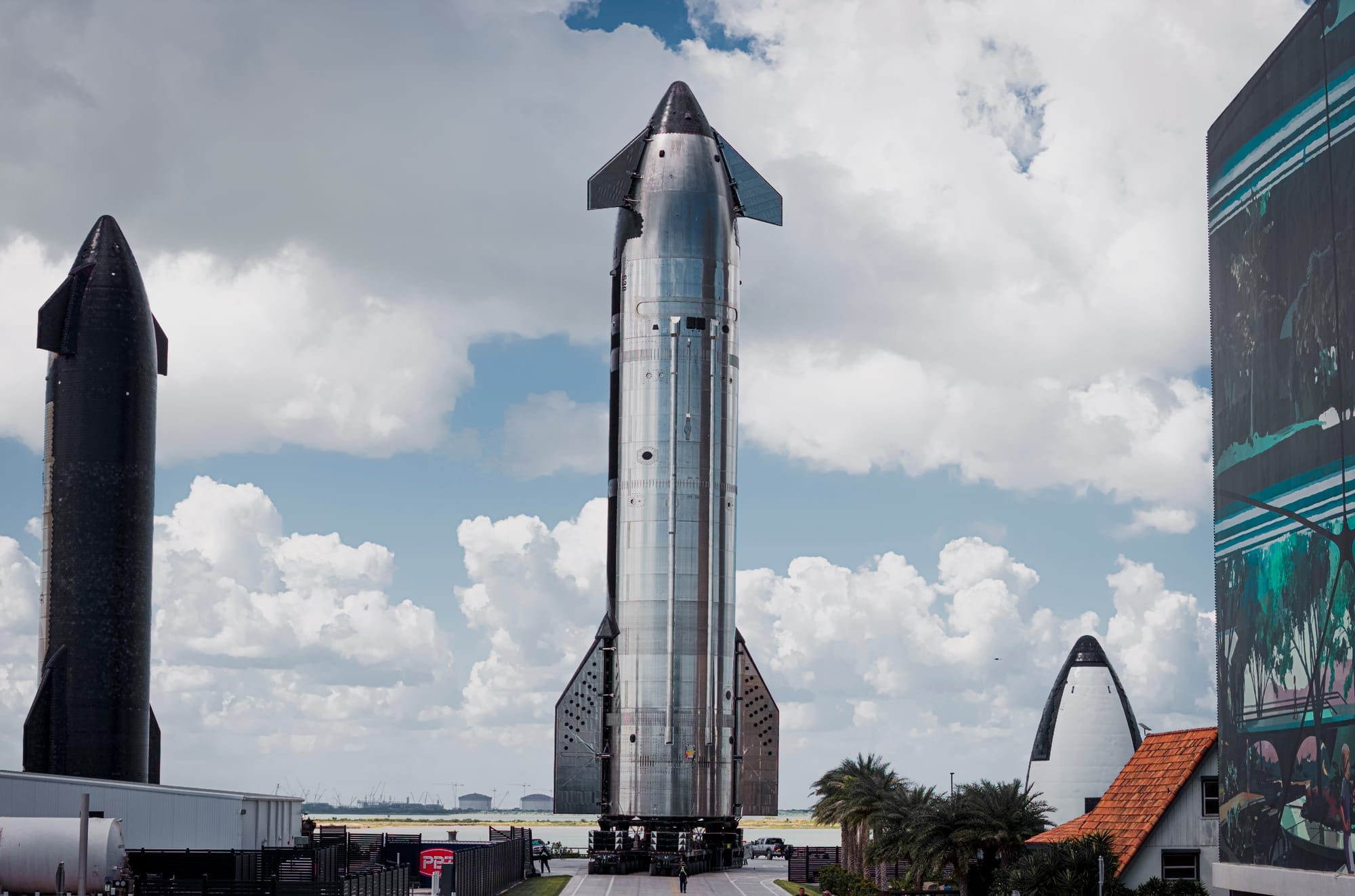
What is Super Heavy?
Super Heavy, also called 'the Super Heavy booster', is the first-stage of SpaceX's Starship-Super Heavy launch vehicle. The giant Super Heavy first-stage is planned to be capable of multiple flights per day with minimal refurbishments and inspections. The vehicle is seventy-one meters tall and nine meters in diameter, excluding its four grid fins and chines. Fully fuelled with liquid methane and liquid oyxgen Super Heavy is believed to weigh 3,600,000 kilograms with an approximate mass of 200,000 kilograms unfuelled.
The Super Heavy first-stage is powered by thirty-three sea-level Raptor engines generating a combined thrust of 7,590 tons, with each engine generating 230 tons of thrust. The outer twenty Raptor engines are unable to gimbal with the inner thirteen being able to for control of the first-stage.
To enable the reuse of Super Heavy, the vehicle has four large grid fins placed in the interstage to assist in guiding and controlling during descent. Super Heavy also has four chines running along the lower third of it to generate lift and assist in stabilization.
Shortly after completing the ascent, Super Heavy relights ten engines, as three were running during staging, and performs a 'boost back' burn in order to return to the launch site. After the 'boost back' burn is completed the engines shut down with Super Heavy being guided by a series of small thrusters and its grid fins. Once Super Heavy is at the correct altitude above its landing location three engines start back up for the landing burn. SpaceX currently plans to have Super Heavy land back at the launch site, or at sea if a problem is detected during descent
Super Heavy also features a hot-staging ring atop of it to allow for a faster and simpler staging process, according to SpaceX. The hot-staging ring has dozens of gaps on the sides to allow for the Raptor engine exhaust of Starship to escape.
